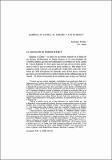Por favor, use este identificador para citar o enlazar a este item:
http://hdl.handle.net/10261/9668COMPARTIR / EXPORTAR:
 SHARE SHARE
 CORE
BASE CORE
BASE
|
|
| Visualizar otros formatos: MARC | Dublin Core | RDF | ORE | MODS | METS | DIDL | DATACITE | |

| Campo DC | Valor | Lengua/Idioma |
|---|---|---|
| dc.contributor.author | Fierro Bello, María Isabel | es_ES |
| dc.date.accessioned | 2009-01-16T12:47:03Z | - |
| dc.date.available | 2009-01-16T12:47:03Z | - |
| dc.date.issued | 2004 | - |
| dc.identifier.citation | Al-Qantara. Revista de Estudios Árabes 25 (2): 299-327 (2004) | es_ES |
| dc.identifier.issn | 0211-3589 | - |
| dc.identifier.uri | http://hdl.handle.net/10261/9668 | - |
| dc.description.abstract | [EN] Qur'anic verses on Paradise (especially Qur'án, 55: 46-78), as well as the Kitab wasf-al-firdaws by 'Abd al-Malk b. Hahíb, allow us to give specific meanings to the interpretation of Madínat al-Zahra' as Paradise and to support it over other possible interpretations (although without necessarily eliminating the latter). On this basis, the variety and asymmetry of the wall decorations in the Hall of 'Abd al-Rahmán III are explained, as well as how certain narratives on Madinat al-Zahrá' came into being. The “green and manganese” decoration of the pottery produced in the town is given a new meaning and some considerations are offered on the name given lo the town. A relationship can be established between Madínat al-Zahra' as Paradise and one of the doctrines attributed to Mundir b. Sa'id al-Balluti, judge of 'Abd al-Rahman III from 339/950 until the death of the caliph. The silence of the Arab sources about this Paradisiac symbolism could be linked to the anecdote on how Mundhir b. Sa'id censured 'Abd al-Rahmán III's building activity. Finally, Madínat al-Zahra has to be studied within tile context of the political and religious struggle with the Fatimids, and more specifically taking into account the situation after the defeat of the "Man of the Donkey", who was presented as an eschatological figure by the Fatimids. | es_ES |
| dc.description.abstract | [ES] Las aleyas coránicas sobre el Paraíso (y en especial Corán, 55: 46-78), así como el Kitāb waṣf al-firdaws de 'Abd al-Malik b. Habīb, nos permiten precisar mejor la interpretación «paradisíaca» de Madīnat al-Zahrā' y dotarla de sentidos concretos, mostrando sus ventajas sobre otras posibles (aunque no desechables). Se explica así no sólo la variedad, sino también la asimetría, de las decoraciones parietales del Salón de 'Abd al-Raḥmān III, se da sentido a cómo pudieron surgir una serie de relatos en tomo a Madīnat al-Zahrā', se puede plantear una nueva interpretación de la decoración en «verde y manganeso» de la cerámica producida en la ciudad y se sugiere otro aspecto más del nombre por el que ésta fue conocida. También se puede establecer una relación con una de las doctrinas atribuidas a Mundir b. Sa'īd al-Ballūṭī, cadí de 'Abd al-Raḥmān III desde 339/950 hasta la muerte del califa. El silencio de las fuentes árabes sobre ese simbolismo paradisíaco puede ser puesto en relación con la anécdota de cómo ese mismo Mundir b. Sa'īd censuró la actividad constructora de 'Abd al-Raḥmān III. Por último, Madīnat al-Zahrā' debe ser estudiada siempre dentro del contexto del enfrentamiento político-religioso con los Fatimíes y, más en concreto, con la situación surgida a partir de la derrota del «Hombre del Asno», presentado como figura escatológica (al-Daŷŷāl) por los Fatimíes. | es_ES |
| dc.format.extent | 1441192 bytes | - |
| dc.format.mimetype | application/pdf | - |
| dc.language.iso | spa | es_ES |
| dc.publisher | Consejo Superior de Investigaciones Científicas (España) | es_ES |
| dc.relation.isversionof | Publisher's version | es_ES |
| dc.rights | openAccess | es_ES |
| dc.subject | Arte islámico | es_ES |
| dc.subject | Cultura islámica | es_ES |
| dc.title | Madinat al-Zahra, el paraíso y los fatimíes | es_ES |
| dc.type | artículo | es_ES |
| dc.identifier.doi | 10.3989/alqantara.2004.v25.i2.135 | - |
| dc.description.peerreviewed | Peer reviewed | es_ES |
| dc.relation.publisherversion | https://doi.org/10.3989/alqantara.2004.v25.i2.135 | es_ES |
| dc.identifier.e-issn | 1988-2955 | - |
| dc.rights.license | https://creativecommons.org/licenses/by-nc/3.0/ | es_ES |
| dc.relation.csic | Sí | es_ES |
| dc.contributor.orcid | Fierro Bello, María Isabel [0000-0003-4736-7224] | es_ES |
| dc.type.coar | http://purl.org/coar/resource_type/c_6501 | es_ES |
| item.openairetype | artículo | - |
| item.grantfulltext | open | - |
| item.cerifentitytype | Publications | - |
| item.openairecristype | http://purl.org/coar/resource_type/c_18cf | - |
| item.fulltext | With Fulltext | - |
| item.languageiso639-1 | es | - |
| Aparece en las colecciones: | (CCHS-ILC) Artículos | |
Ficheros en este ítem:
| Fichero | Descripción | Tamaño | Formato | |
|---|---|---|---|---|
| Madinat_al_zahra.pdf | 4,77 MB | Adobe PDF |  Visualizar/Abrir |
CORE Recommender
SCOPUSTM
Citations
25
checked on 16-abr-2024
WEB OF SCIENCETM
Citations
21
checked on 27-feb-2024
Page view(s)
772
checked on 22-abr-2024
Download(s)
135
checked on 22-abr-2024
Google ScholarTM
Check
Altmetric
Altmetric
Este item está licenciado bajo una Licencia Creative Commons

